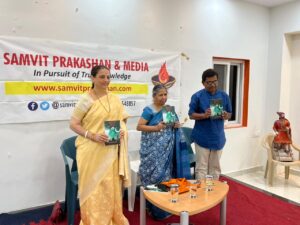
In the beautiful book launch program organized by Samvit Prakashan, author, senior journalist, researcher and well-known YouTube channel `Rakalokam’s producer and presenter Sri Kasturi Raka Sudhakara Rao’s Telugu book `Adugaduguna Gudi Undi’ was launched on the evening of 19th Nov 2022 at AS Rao Nagar, Hyderabad. The book is published by the reputed quality books’ publisher Samvit Prakashan.

`Adugaduguna Gudi Undi’ (A temple at every step) is a gem of a book, written in an engaging style in Telugu. It is a collection of travel blogs/stories relating to forgotten temples of a bygone era, remote inaccessible and sacred temples from various corners of Bharat, and the countless legends behind them; some examples include Matouli, Morena district and Agar Malwa in Madhya Pradesh; Kuldhara abandoned villages in Jaisalmer, Rajasthan; Avancha Timmajipet, Gangapuram, Saleswaram, Manyamkonda temples in Mahboobnagar district; Rayaraopet, Varadarajapuram, Maheswaram, Pillalamarri, Ammapalli, Chaya Someswara temples near Hyderabad, Bhadrachalam choultry; Korukonda and Brahmasamedhyam temples in East Godavari district, the Ramnami tribes of Chattisgarh, the dead soldier‘s shrine in Sikkim, and many more. The beautifully illustrated book is a tribute to legends and histories of Bhakti and Bhaktas of Bharat and will instill Bhakti in us towards our shared cultural heritage. The book is a celebration of Hindu temples, the innate bhakthi of the devotees, and reflects the innate soul of the nation.
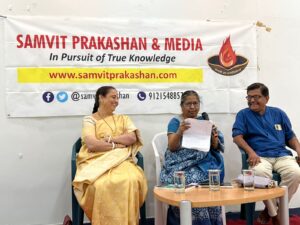
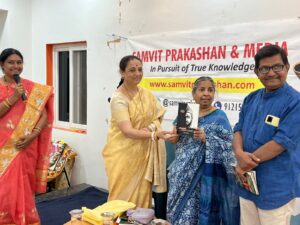
Dr P. Sasirekha, Retd professor and HoD, Sanskrit Dept, Osmania University, and author of several works, in her inspiring and scholarly keynote address presented a detailed analysis of the author’s style of writing, the poetry and the beautiful expressions in the book which reflect the world of `kavya rasa’ and `anubhuthi’, she said the book has all the features of a classic and she was compelled to read it continuously evoking the feelings of santhi, asanthi and visranthi ( peace, unease and relaxation). She said every story had glimpses of history, Vedantha and an aesthetic appeal. Technically, the brilliantly written work has the touch of `Rasa’ and `Dhwani’, and has a beautiful appeal which evokes Bhakti in the reader.
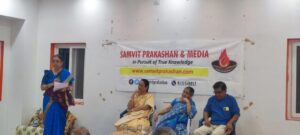
The book was formally launched by Prof Dr Sasirekha, the author Sri Raka Sudhakar Rao and Smt Parimala Nadimpalli from Samvit Prakashan. Ms Shailaja from Samvit presented a brief introduction of the book.
The author Sri Raka Sudhakar Rao in his wonderful talk said that the place of the temple/ aalaya in the lives of Bharatiyas is immense, one can say that the essence of Bharatiya culture is Temple Culture. The word for temple in Telugu, and many other languages `Aalayam’ is so ubiquitous that it appears in many words like devalayam, premalayam, anaathaalayam and even souchalayam. He said in our tradition which is handed over from thousands of years, the temple was not just a place of prayer as in abrahamic religions, but serves multiple functions of being a place of sacred worship, a school, a school teaching Vedas, a food dining place, a place for physical exercise and training, a treasure house of knowledge and many more, the lives and livelihoods of the Hindus in ancient India centered around the sacred temples. People who attack Indian civilization choose to target temples, schools and families as that will break the back of the nation.
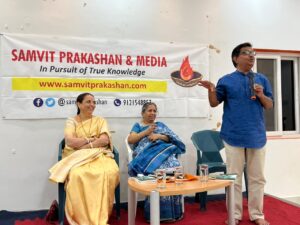
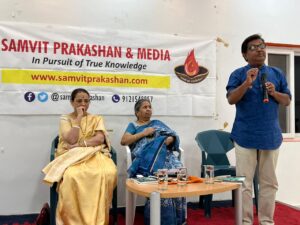
The stories in the book belong to the ordinary people with extraordinary devotion towards their Gods and Goddesses and temples. There are stories of devotees who live with the same divinity of serving others as deities as shown in the Bhadrachalam story, the Ramnami tribe of Chattisgarh which made their whole bodies as temples for Bhagwan Srirama, as a symbolic protest against people who prevented them from entering temples. He said our perspective on temples should change, the temple traditionally is a sacred place where we worship the deities to protect us with inner peace, security and fearlessness, not for seeking desires and making demands.
The temples are the very foundation of not only our national culture, but also generate huge revenues, livelihoods and wealth. The mantra of Sankalpa recited by the Pujaris in the temple should be our National Charter – Kshema (security), Sthairya ((courage), Dhairya (patience), Ajaya, Vijaya (victory), Abhaya (fearlessness), Veerya (valor), Ayuh (longevity), Arogya (health), Aiswarya ( prosperity) Abhivruddhi (development and progress). The temples are for our spiritual progress as well as for economic and social development of the society. The various items and paraphernalia sold around the temples generate millions of livelihood opportunities for the poor and generate immense revenues. The annual Ganesh Utsav in Hyderabad generates Rs 5000 crores revenue in just about 10 days in one city. In a single city Kolkata, the navaratri Durga puja festivities generate Rs 1 lakh crores. Over 15 years ago, PRIA, an NGO estimated that just the smaller temples’ Hundis generated Rs 22000 crores as donations, and more than 80% of the monies are donated by devotees earning less than Rs 10000 per month. These studies show the devotion and total involvement of the ordinary Indians towards their temples and deities. There is an interesting story the from ancient India on the Goswami Mutt temples; when the Vaisya community traveled far and wide in their caravans outside India to conduct trade, they would deposit money and receive tokens to get their monies reimbursed back in India from the Mutts! It shows that the temples even functioned as the first banking system in the world. Sri Raka Sudhakar Rao concluded by saying that we need to revive the glory of our temples by playing an active role collectively as a society.
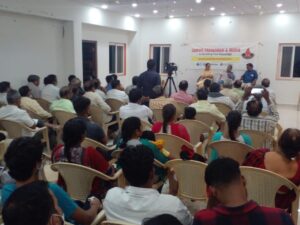
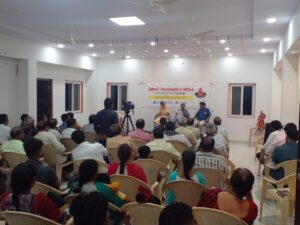
The book-launch concluded with large numbers of audience inspired by the Samvit Prakashan’s latest book `Adugaduguna gudi undi’.